Programmatic Advertising Explained: What It Is and How It Works
Do you recall how simple digital advertising used to be? Back in the day, marketers just had to choose a website that appealed to a certain audience and buy space to run an ad there for a set period of time in the hopes that it would be engaging enough to get some random conversions.
As the digital market has immensely grown in size and popularity, its complexity has reached wild frontiers. For better or for worse, digital advertising has become an extremely intricate task for those that aim to stay on top, forcing human labor to call in the smartest, swiftest, and most rational ally available: artificial intelligence.
According to Statista, worldwide programmatically sold advertising was worth 418 billion U.S. dollars in 2021. The figure is expected to reach 725 billion in 2026. Insider Intelligence found that 84.9% of the U.S. digital display ad market in 2021 was driven by some form of programmatic advertising, confirming that this methodology is soaring.
That said, a Drift study states that 77% of the interviewed marketers have less than a quarter of their daily ops intelligently automated, and 18% say they haven't programmed any chores at all.
There is still time for maverick B2B marketers to jump into the programmatic advertising spaceship before it continues its ascension, and this guide's purpose is to lay down the foundation of all there is to know about this exciting topic. So buckle up and let's go full throttle on this crazy ride.
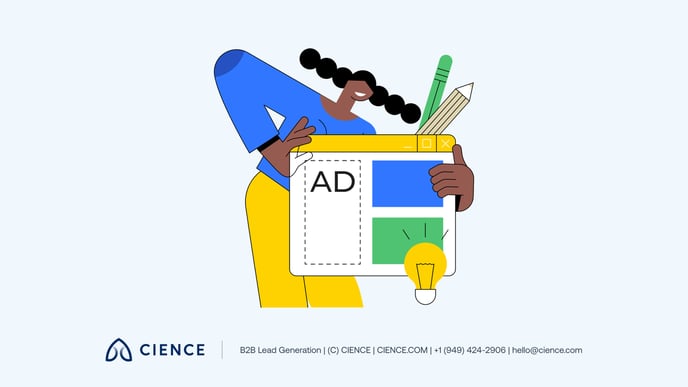
What Is Programmatic Advertising?
Programmatic advertising can be defined as the automated buying and selling of digital ad space in real-time through artificial intelligence and machine learning software. Its main goal is to improve efficiency and transparency for both advertisers and publishers.
This automated ad buying process can target audiences based on demographics, psychographics, purchase intent, and other digital behaviors across desktop, mobile, and video ad displays.
Programmatic media buying uses collected data to decide which ad style has better chances to engage a specific user depending on its data footprint and applies it at the right time for the least cost.
Once the parameters of an advertising deal are set, programmatic media buying is automatically carried out in accordance with those terms in a fraction of a second.
Here are some of the programmatic ad exchanges for publishers:
- A straightforward, automated method for selling ad inventory
- Maximizing the value behind ad pricing strategies
- Increasing ad relevancy and improving the overall user experience
There are a number of reasons why programmatic advertising is used by marketers as well:
- A high-quality audience is reached through precise targeting filters.
- Real-time changes can be made to improve results at any stage of the campaign.
- Marketers can access detailed reports of the ad campaign progress whenever they need them.
Standard programmatic digital display ads often have a CPM (cost per mile or "cost per thousand impressions") of $0.50 to $2.00, and video ads go around $12.64 CPM. These prizes may shift depending on the ad space market.
B2B marketers typically think of programmatic advertising as a means to improve the return of investment (ROI) rate. While programmatic media buying can be planned internally, a few external platforms are absolutely necessary to perform a programmatic display campaign:
Demand-side platform (DSP)
A DSP is software that focuses on the buying part of the deal. It connects brand advertisers to available ad space online, and then programmatically purchases and manages digital advertising inventory from multiple publishers, enabling advertisers to purchase impressions via ad exchanges across a variety of publisher websites.
Data management platform (DMP)
A DMP gathers, organizes, and deploys first-, second-, and third-party audience data from all online, offline, and mobile sources linked to a brand. This tool is incredibly helpful to create the ideal customer profiles (ICPs) that will be used by both DSPs and SSPs to target the digital programmatic advertising campaigns.
Supply-side platform (SSP)
On the other hand, an SSP focuses on programmatic selling. It uses the same ad networks and exchanges to bargain for the sale of advertising space. It is their responsibility to fill this inventory of advertising space with the most profitable ad variants.
Artificial intelligence and machine learning are even able to help optimize a programmatic campaign's performance over time, demanding little assistance from the campaign manager.
That said, there are still certain bidding strategies (like fixed price and dynamic price models), pay-per-click (PPC) advertising techniques, and frequency capping actions that can further enhance the chances of success of programmatic ad campaigns.
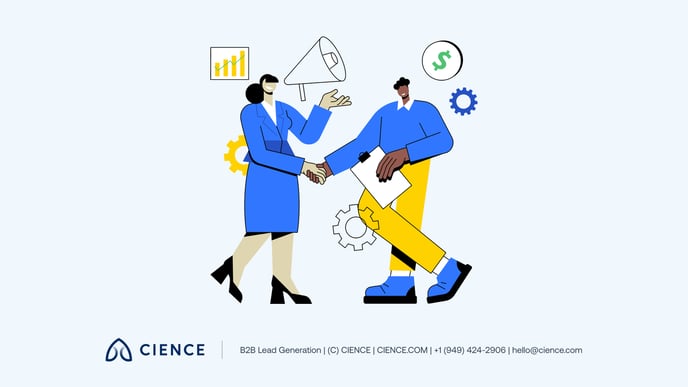
Why Use Programmatic Advertising for B2B Marketing?
Nowadays, high-quality leads are well-informed on how brands use their data trails to reach out to them. This means that they will be expecting tailor-made proposals that could address their needs from the very start of their buyer's journey.
Digital programmatic advertising has become a great aid for account-based marketing (ABM), as it allows marketing reps to trigger engaging, data-powered ads to narrowed-down audiences all across the Internet.
Here are five compelling reasons why B2B marketing reps are leveraging programmatic ads to accelerate conversions:
Budget optimization
Programmatic display benchmarks allow marketing teams to target users with a laser sight. By avoiding budget waste on online visitors who are unlikely to be interested in your product, the advertising resources are spent more wisely.
Real-time measurement
Advertisers can immediately evaluate and enhance outcomes by adjusting the parameters of an advertising deal. This way, they have complete control over their ad spending and don't have to wait until the end of the campaign to apply meaningful insights.
Multichannel outreach
One of the most treasured characteristics of programmatic ads is their versatility. Marketing reps can use them to reach customers on a wide variety of devices, including mobile, desktop, tablet, in-app, TV, and even out-of-home screens.
Ever-evolving targeting
As buyer personas and customer profiles keep on becoming more and more detailed, the most sophisticated DMPs can automatically update the most-wanted characteristics for the desired prospects depending on the displayed intent data.
Large-scale campaigns
Through the use of retargeting and programmatic advertising, marketing teams can reach a huge number of users without sacrificing personalization. The volume of the audience mainly depends on the deployed budget, the targeting parameters, and the number of brands bidding for the same keywords and other triggers.
How Does Programmatic Advertising Work?
Now that the programmatic advertising definition has been pinned down, let's take a closer look at how it functions. As mentioned before, the whole process is set in motion almost completely automatically, and it all happens within milliseconds.
While there may be a few variants in the process, these are the key steps that need to occur for a programmatic advertising campaign to go live:
- Publishers use their SSP software to create ad space on their websites and link their proposals to an ad exchange.
- Advertisers connect their DSP software to a compatible ad exchange and establish their target audience, cost, budget, and other relevant data.
- A visitor comes to a website and the ad exchange receives all the user's information thanks to the displayed cookies.
- The visitor will participate in the real-time bidding (RTB) auction if their information matches the target audience that the advertiser specified before.
- The advertiser with the highest bid will win the ad space for programmatic RTB, and the ad (which had to be submitted before the bidding started) will be displayed to the desired visitor.
- The publisher finally gets paid for the displayed ad, and the process starts over with every new visitor.
Real-time bidding contributes to around 90% of the programmatic ad buying process. Nevertheless, there are additional elements inside the programmatic advertising system that need to be considered for success.
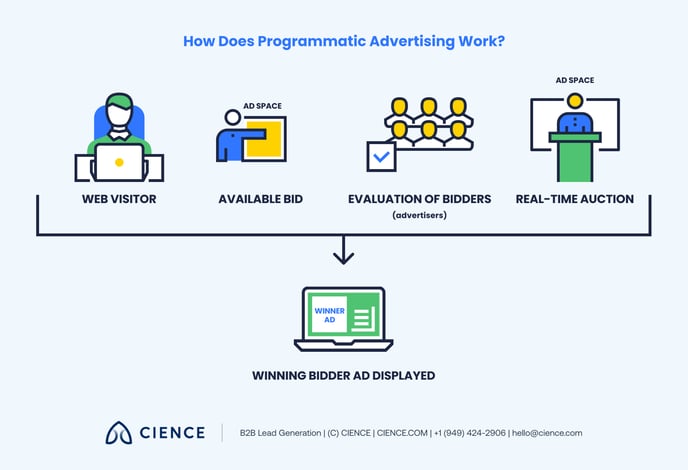
Programmatic Advertising Ecosystem
As mentioned before, the DSP and the DMP must be connected on the advertiser's side while publishers need to use an SSP to distribute their available inventory across multiple ad exchanges. Once these components are set, the algorithm will launch the campaign and determine where your ad budget is best spent.
As long as the marketing reps continue to feed the programmatic solution information about the audience, budget, and key performance indicators, the algorithm will keep on looking for areas of improvement.
However, there are other key concepts in the programmatic digital display advertising world that need to be in place for the ad campaign to function properly. Let's go over the most important ones:
DMPs and CDPs
Both publishers and advertisers employ internal data centers and data brokers to enhance the targeting capabilities of their ad serving procedures.
Data management platforms rely on massive amounts of third-party data to enable teams to gain a deeper understanding of the targeted users.
On the other hand, customer data platforms (CDPs) are used to hold, manage, and integrate first-party data from customer profiles and closed leads that started as website visitors.
Most B2B marketing experts merge both data sources to access a complete picture of what a prospect account craves, their business drivers, ambitions, needs, and likelihood to buy.
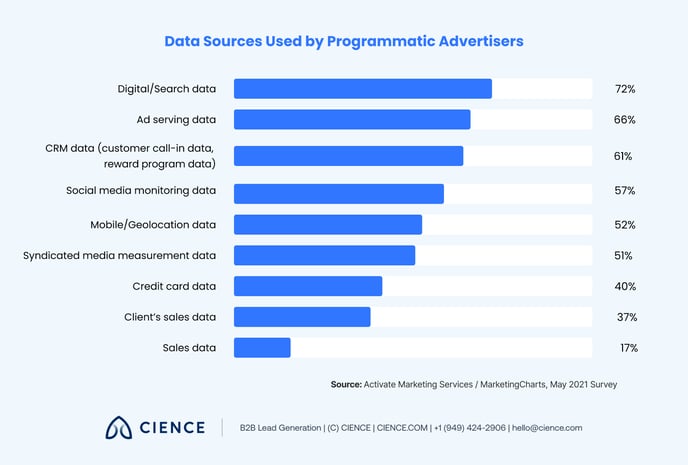
Ad networks and ad exchanges
The two most important intermediary parties in the programmatic ecosystem are ad networks and ad exchanges:
- Ad networks offer the service of grouping or "bundling" publisher ad inventory into handy categories for marketers to purchase.
- Ad exchanges enable ads to be automatically bought and sold on an impression-by-impression basis through real-time bidding.
The main difference between both concepts is that while ad networks still require human interaction to perform, ad exchanges are triggered automatically during the programmatic display advertising transaction.
Types of Programmatic Advertising
This guide has already covered the most relevant definitions and processes behind programmatic advertising. Yet, there are still a couple more topics that must be explored to access a full understanding of this search engine marketing (SEM) approach.
Programmatic ad campaigns can be divided into four main categories:
Open marketplaces
The most basic type of programmatic ad deals. Also referred to as "open auction," these environments employ the real-time bidding system to connect the ad spaces offered by publishers with the ad displays proposed by the advertisers.
There are no restrictions in this deal, meaning that every publisher and advertiser is free to connect as long as the budget and the prospect's characteristics match the offer.
Private marketplaces (PMP)
These marketplaces are a bit more exclusive. Only specific buyers (sometimes even just one) are invited to access a very specific pool of users, and even the ad inventory could be limited to certain ad formats.
The reason behind this preferential bidding is that publishers may have a niche-related audience and want to exercise control over what advertisements will run. Human interaction between advertisers and publishers is needed to establish a deal.
Preferred deals
Preferred deals are among the most flexible and liberal types of digital ad buying agreements, as they don't force the publisher nor the advertiser to commit their resources upfront to the deal.
Instead, "preferential" pricing conditions are pre-established, resulting in a private ad buying agreement that is advantageous to both parties whenever they want to use it.
Guaranteed deals
A guaranteed deal is an agreement between a publisher and an advertiser that specifies the CPM, length of the advertising campaign, and other specifics like ad placement places.
Once the deal is made, the publisher "reserves" the selected ad inventory, as it is now exclusively meant for the chosen advertiser.
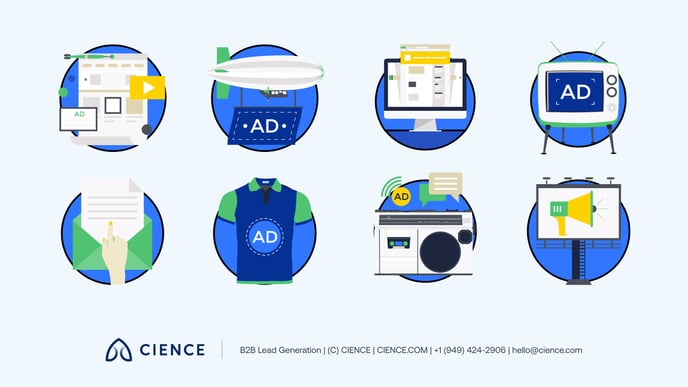
Most Popular Programmatic Ad Display Formats
Most publishers support several styles of ad spaces through their platforms, and it is the duty of advertisers to exploit these options to their advantage.
A/B testing is an almost mandatory practice for this stage of programmatic display advertising, as the best way to confirm which ad performs the best for a certain audience is to experiment with the different display formats. Here are the most common ones:
Display
Do not fix what's not broken. Display is the most traditional buy programmatic advertising format. However, ads have changed from static to dynamic due to ongoing technical advancements, mobile optimization, and better data use.
Video
Eye-catching videos create an amazing opportunity to push a luring call to action (CTA). Programmatic video comes in two different varieties: instream and outstream (with programmatic banner ads videos sometimes classified as outstream ads). While production can be more elaborated, the programmatic video figure is more than half of the total predicted video ad spend of $9.59 billion.
Native and social
Social networks have become powerful showcases for B2B brands through the years. These programmatic advertisements are embedded among the content of the most important social media platforms, adapting to the ad spaces they provide.
Voice
Amazon's Alexa and Spotify make great examples of the reemergence of the voice format. This choice provides great contextual and user-focused targeting options. Thanks to Google now allowing marketers to purchase programmatic audio advertisements using its own DSP alternatives, the voice ads trend has just begun.
Television
Nowadays, programmatic television advertising expenditure is not significant (in the U.S., it accounts for just 2.5% of total ad spend). However, a number of significant market participants, including Netflix and Google, are developing the infrastructure required to support the transition to a more programmatic TV approach.
Digital out-of-home (DOOH)
Programmatic ads are swiftly entering the out-of-home marketing arena with the adoption of digital signage technologies. This system allows advertisers to refine the creatives shown on screens in different locations using live audience data around the area. While this format is still under development, we can expect to see more applications in the following years.
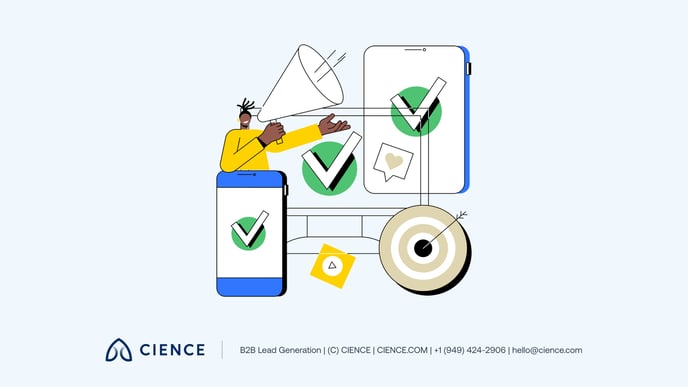
How to Create a Programmatic Advertising Campaign
This guide would be complete without the practical steps to craft a real programmatic ads campaign. By mastering programmatic SEM marketing, you and your team will be able to launch your ads all across the Internet without any restrictions, completely free to target your prospects with as much precision as you wish.
Here are the recommended actions to create your very own programmatic advertising operation:
1. Set objectives.
Like any other marketing effort, you must begin by establishing clear goals. What are you trying to achieve? Improving your brand awareness, increasing your sales, or boosting your ROI are all great options, but you must decide what is the main priority of the campaign.
2. Choose the ad format you want to go with.
Here is where creativity can run wild. Each of the previously explained ad styles aligns better with a specific advertising goal, so marketing experts should be able to craft the ad format that might trigger the most conversions out of the knowledge they hold about the prospect.
3. Sign up for the perfect demand-side platform.
There are dozens of DSPs available on the market. Before choosing which one works best for your brand, budget, and goals, consider the following features that might come in handy through the whole campaign:
- No platform charge: You can sign up, make a deposit, and begin purchasing ad spaces immediately.
- Basic targeting choices: browser, operating system, language, location, etc.
- Partnerships with trustworthy SSPs, with access to at least fifteen different sources.
- Analytics in real-time: Track your advertising campaign without reporting delays.
- Access to the technical support team via live chat.
- Availability for all significant formats: banner, mobile, video ad formats, etc.
- Simple-to-use interface.
- Transparency in data at all times.
CIENCE GO Digital is a top-notch example. Our bidder-as-a-service system enables digital marketers to access a highly customizable RTB cloud platform. This way, they will be able to target millions of business users using hundreds of B2B filters such as title, industry, company size, and technologies used.
4. Set your budget.
The best part about programmatic advertising is that you can set the CPM you can afford. Also, your team will be able to specify the programmatic ad campaign duration by entering the start and end flight dates.
You can even enter limits for impressions and for ad spending. These limits can go from a daily basis to a lifetime. Last but not least, many marketing experts adjust the frequency cap, a parameter that implies the number of ad views by the same user. This way, you may prevent your ad from being shown to the same user too many times.
5. Select your target.
It is time to go back to your DMPs and CDPs to correctly identify the most prominent characteristics of your buyer personas so the audience targeted by your campaign is as accurate and qualified as possible.
Most publishers will allow you to fill in the gaps in fields like:
- Language
- Domain categories
- Operation system
- Geolocation
- Device type
- Traffic type
- Connection type
6. Partner up with a publisher.
Select websites with excellent click-through rates, ROI, conversion rates, audience, sales, engagement, and other data you deem crucial for your campaign.
When purchasing direct programmatic ads, you can even look into the publisher's philosophy and core values so they can match your own. It all comes down to wanting to interact with website visitors who are already actively using the publisher's platform.
7. Launch the campaign.
Everything has led you to this point. The only way to confirm the quality of your data is to actually use it. Programmatic advertising is all about experimentation.
You can always begin with a limited budget to confirm your hypothesis on how your audience will react, how many leads will be lured by certain messages, imagery, CTAs, and which of these prospects actually became closed deals.
All this information can lead to extremely valuable insights on how to enhance your future campaigns, so don’t be afraid to try new things out.
8. Analyze and optimize efforts.
Monitor and evaluate the advancement of your entire campaign based on your objectives and goals. Check the effectiveness of the ad formats, selected target, and direct publishers to evaluate how they performed in terms of key performance indicators (KPIs).
Adjust your creatives, bid, and other variables of the campaign, then rerun the campaign again. Remember that ineffective publishers, arts, displays, audiences, and budgets can be changed at any point.
Leverage Programmatic Advertising to Generate More Leads
Programmatic advertising is more alive than ever. While many B2B marketers still trust the standard SEM platforms provided by the most-used browsers and social networks, a rising number of digital experts are choosing to let go of the limited structures and gain full control over their ads.
The best programmatic advertising platforms are emerging as a result of general technological advancements like:
- Machine learning and artificial intelligence (AI) keep on becoming more sophisticated and easier to access.
- Trustworthy first and third-party data providers are moving into a more responsible posture toward prospect information.
- The use of identity graphs and device fingerprinting enables marketers to target the right audiences without sacrificing individual privacy.
- Ads can be more specifically tailored based on user interests thanks to dynamic ad creatives.
As high-quality leads continue to demand a more personalized line of conversation, the B2B brands that wish to maintain and raise their relevance will have to adapt their efforts to the technological trends. Programmatic is the new emblematic.
A Few (Related) Sales Posts
 Featured image: What Is a Demand-Side Platform? DSP Guide with Examples - Read full post: What Is a Demand-Side Platform and How Does It Work in Advertising?
Featured image: What Is a Demand-Side Platform? DSP Guide with Examples - Read full post: What Is a Demand-Side Platform and How Does It Work in Advertising?
What Is a Demand-Side Platform and How Does It Work in Advertising?
 Read full post: Digital.com Names CIENCE Best BPO Service Provider of 2020
Read full post: Digital.com Names CIENCE Best BPO Service Provider of 2020
Digital.com Names CIENCE Best BPO Service Provider of 2020
 Read full post: How to Prospect on LinkedIn: A Complete Guide with Examples
Read full post: How to Prospect on LinkedIn: A Complete Guide with Examples


